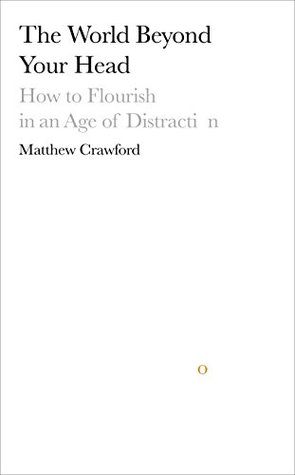More on this book
Community
Kindle Notes & Highlights
Read between
April 6 - May 26, 2018
The Latin root of our English word “attention” is tenere, which means to stretch or make tense. External objects provide an attachment point for the mind; they pull us out of ourselves. It is in the encounter between the self and the brute alien otherness of the real that beautiful things become possible: the puck-handling finesse of the hockey player, for example.
Unlike animals that live in the moment and merely cope with their world (however smoothly), we are erotic: we are drawn out of our present selves toward some more skilled future self that we emulate. What it means to be erotic is that we are never fully at home in the world. We are always “on our way.” Or perhaps we should say that this state of being on our way to somewhere else is our peculiar human way of being here in the world.
Zengotita points out in his beautiful book Mediated, representations are addressed to us, unlike dumb nature, which just sits there. They are fundamentally flattering, placing each of us at the center of a little “me-world.”1 If the world encountered as something distinct from the self plays a crucial role for a person in achieving adult agency, then it figures that when our encounters with the world are increasingly mediated by representations that soften this boundary, this will have some effect on the kind of selves we become.
The point of the activity is the activity itself. Talbot Brewer has elaborated such “autotelic” activities and finds that they have a certain structure to them: they are guided by intimations of something valuable that you are trying to bring more fully into view through your activity. In the course of your repeated efforts, you find that what you are aiming at is a moving target, because it reveals itself only in the course of your pursuit. Brewer gives the example of a blues singer who is trying to find just the right phrasing to convey the subtle and complex emotional register she is aiming
...more
For Polanyi, scientific inquiry is above all a practice, best understood as a kind of craft. “I regard knowing as an active comprehension of the things known, an action that requires skill.”
Things show up for us in daily life, not as they would to a disinterested spectator, but as things that we “have to do with” in some way.
This is what an artist does. She must defamiliarize herself with her everyday perceptions, which depend on—are conditioned by—her past experiences, including the experience of inhabiting a world that is thoroughly conventional. She has to try to perceive as a baby does, or as the empiricist supposes we all do, but this is a subtle and extraordinary accomplishment. There is nothing infantile about good art, but it does show us the world as viewed by a consciousness that has, for a spell, liberated itself from conventionality.
A carpenter, for example, answers to his level, his square, and his plumb bob: standards that have universal validity. Yet it is up to him how these minimal standards will be met in the graceful arc of a stairway’s handrail.
If we can put aside for a moment our centuries-long preoccupation with liberation, we might think differently about authority. The key would be to conceive authority in a way that is free of those metaphysical conceits that provoke an allergic reaction in the modern mind. Recall once more Iris Murdoch’s description of learning Russian. The “authoritative structure” she invokes as a counterweight to the self is not the law of a punishing Jewish god, nor the promiscuous love of a Christian one. Rather, it is the authority of a skilled practice that “commands my respect” for reasons internal to
...more
Technologists who work in a long tradition with inherited forms also offer a useful contrast to our current image of the innovator-entrepreneur as a sort of existential hero who creates the New ex nihilo. After a period of solitary gestation in a California garage, he emerges to disrupt us and deliver us.1
A big pipe organ thus expresses both humble piety and vaunting pride at once. It can be shockingly indiscreet in this latter role; the organ often dwarfs the ostensible altar. But perhaps these tendencies get blurred together in the life of a congregation. When the choir is at full song, the stained glass is rattling loose, and the whole house seems ready to launch, what then? Then the organist pulls out all the stops. He shifts his weight to the right. His left foot is poised over the leftmost pedal, the low C, and now he stomps it, sending a thousand cubic feet of air per minute through
...more
manufactured experiences promise to save us from confrontations with a world that resists our will.


